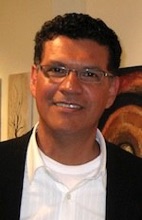FRANCISCO CASTRO LOSTALO: about the artist

BIOGRAPHY
Born in Costa Rica in 1958, Francisco Castro Lostalo is a sculptor, painter, multi-media artist, art instructor and organizer of artistic events. He pursued an interest in art from a young age, taught art in high schools and operated a successful ceramics school. Upon moving to Canada in 1989, he began to focus on creatiting his own original art and, later, studied the techniques of master stone sculptors in Tuscany, Italy. While living in Canada, he exhibited his work in Ottawa and in several Toronto galleries. He also returned to Costa Rica frequently, where he created and exhibited his work, and organized and participated in a wide variety of artistic events.
Beginning in 2010, while living in Canada, Francisco created more than 30 sculptures using a portion of the 45,000 white Carrara marble panels that previously covered the facade of Toronto’s 72-storey First Canadian Place office tower. By grinding away 35 years of grime, Francisco rescued the still almost pure white, sculpture-quality marble underneath. He then cut, combined and carved the panels into appealing original sculptures.

An accomplished sculptor, Francisco is a member of the Rome-based International Association of Monumental Sculpture Events (AIESM), and has organized two international monumental stone sculpture symposiums in his native Costa Rica. In the second of those, “Spirit of Diversity”, held in 2013, both the event and the sculptures it produced celebrated cultural diversity in Costa Rica and around the world.
Driven by inspiration, Francisco is as passionate working with a brush as he is with a chisel. His most recent paintings -- large format collections in acrylic, resin and multi-media -- demonstrate his passion for color, both in abstract works that can be found in his “Potpourri” and “Four Elements” series, and in his lifelike depictions of “Giants of the Deep”, all of which use deep hues, strong light, varied texture and reflective finishes to create depth and drama.
He works in a wide range of media, sculpting in stone as well as in fiberglass and resin, ceramic, bronze and wood; and painting in acrylic and resin, watercolor, and oil. His works are found in public art instatllations and in private collections in Costa Rica, the Caribbean, Chile, Argentina, the United States, Canada, the United Kingdom, France, Belgium, Switzerland and Egypt.
In 2020, Francisco returned to live full-time once again in Costa Rica, where he now operates Visions Art Center, which includes an art gallery, an art school, and studio spaces for other artists.
RÉSUMÉ
SCULPTOR, PAINTER & MULTI-MEDIA ARTIST
ORGANIZER OF ARTISTIC EVENTS
OWNER/OPERATOR, Visions Art Center, Liberia, Costa Rica
MEMBER, International Association of Monumental Sculpture Events (AIESM)
PUBLICITY for Projects in Canada
- Toronto Star: “Sculptors recycle First Canadian Place marble”, August 17, 2010
- Globe and Mail: “The upside of losing all your marbles”, December 31, 2010
- Toronto Star: “Play Me, I’m Yours puts 41 pianos across city of Toronto”, July 7, 2012 View Piano Photos
- Global Toronto News Hour TV coverage: “Play Me, I’m Yours”, July 5, 2012
ARTIST’S STATEMENT
My first passion as an artist was to create works reflecting the amazing beauty that surrounded me as I grew up in my native Costa Rica. Eventually I realized that not everyone sees the world as I do, or truly appreciates what they see. Too many take the beauty around them for granted. Worse, too few are conscious of its fragility and how humans threaten it further by carelessness or intentional destruction.
Today, the main objectives of my work are to highlight the essential yet fragile beauty of our world, to capture and preserve that beauty as I see and interpret it, and hopefully to help others appreciate it through my eyes. I strive to create work that is evocative and inviting. Unlike artists whose work is intended to challenge or provoke their audiences intellectually, I seek to stimulate mine emotionally.
My body of work as a painter, sculptor and multi-media artist is eclectic. My subjects and style reflect my hispanic roots in Costa Rica as well as the multicultural environment of my adopted Canadian home. Much of my art is neither purely abstract nor entirely realistic but a blend of the two, in varying degrees, expressing my personal impressions and interpretations of the subjects. In addition, I constantly work to stretch my creative limits by exploring new subjects, working with different media and developing new techniques.
Unifying themes of my work are my passion for beauty, my awe of nature and my concerns that the beauty in nature is being threatened, that too many species are endangered and precious resources are being depleted. These themes are reflected in my paintings, such as recent series titled “Potpourri” and “Giants of the Deep”, and also in my sculptures. My marble sculptures are carved from Italian Carrara panels that previously formed the facade of Toronto skyscraper First Canadian Place. Through that material, I pay respect to the traditional medium of the great master sculptors in history, without further depleting our resources.
Both in my sculptures and in my paintings, I deliberately choose durable media that contrast directly with the fragility or vulnerability of my subjects.
Strong colors dominate my paintings. I use the vibrant palette of tropical nature. It has been said that music is the language of the soul, and that color is music for the eyes. My brushes are the instruments of my music.
Composition, texture and the use of multi-media elements help to distinguish my work from that of other artists working in acrylic and resin. However, the greatest distinction is made possible by a special technique I developed to blend and apply acrylic and resin simultaneously. This makes execution of the work considerably more challenging, but adds depth and intensity of color. Most of all, it allows me to create effects that are not possible when resin is applied on top of acrylic paint. Taken together, the large format of the paintings, their strong colors, varied texture and durability make them appealing to the eye, and inviting even to touch.